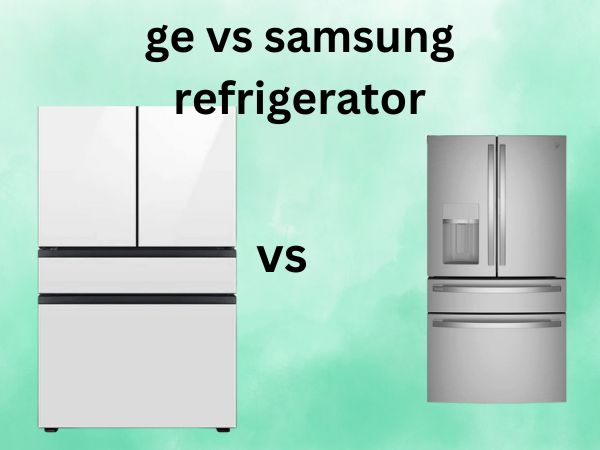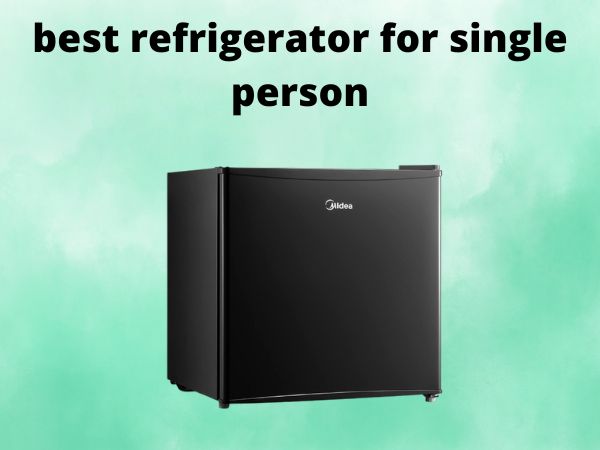GE vs Samsung Refrigerator [Which Brand Deserves Your Kitchen in 2025?]
When it comes to outfitting your kitchen with a reliable refrigerator, two giants often stand at the forefront of consideration: GE and Samsung. As someone who’s spent countless hours researching and testing various refrigerator models, I understand how crucial this decision is for your home. After all, this appliance will preserve your food, complement your kitchen design, and potentially serve your family for the next decade or more.
In today’s comparison, we’re diving deep into what makes each brand unique, exploring everything from cooling technology to smart features, design aesthetics to long-term reliability. By the end of this comprehensive guide, you’ll have a crystal-clear understanding of which refrigerator brand aligns best with your specific needs and preferences.
Let’s open the door on this cool comparison and see what’s inside!
Table of Contents
Brand Overview: The Legacy of GE vs Samsung’s Innovation
Before we dissect specific features, let’s understand the companies behind these popular refrigerators. The brand history often reflects in their design philosophy and technological approach.
GE Refrigerators: American Heritage and Engineering
General Electric (GE) represents more than just an appliance manufacturer—it’s a piece of American industrial history. Founded in 1892, GE has been producing refrigerators for American homes since 1927, making them one of the oldest refrigerator brands still in production.
GE’s approach to refrigeration has always been grounded in reliability and practical innovation. Rather than chasing every fleeting trend, GE tends to perfect core technologies while gradually introducing proven innovations. Their manufacturing primarily occurs in Louisville, Kentucky, at what they call “Appliance Park,” though some production has moved overseas in recent years.
What sets GE apart is their deep understanding of American household needs. Their engineering team focuses on creating refrigerators that handle the shopping habits and food storage needs typical of American families. This legacy of understanding their customer base gives them an edge in designing intuitive storage solutions.
Samsung Refrigerators: Korean Tech Giant’s Kitchen Revolution
Samsung’s story is quite different. While now a global technology leader, Samsung only entered the refrigerator market in the early 1970s, making them relative newcomers compared to GE. However, what Samsung lacks in refrigeration history, they make up for with technological innovation and bold design choices.
As a company that dominates the electronics market, Samsung approaches refrigeration with a tech-first mindset. This has led to some groundbreaking features like touchscreens, cameras inside your fridge, and some of the most advanced cooling systems on the market.
Samsung has strategically positioned themselves as the refrigerator brand for the digital age family. Their manufacturing primarily occurs in South Korea, Mexico, and China, with a focus on integrating cutting-edge technology into everyday appliances.
The company’s willingness to experiment and push boundaries means they often introduce features that eventually become industry standards. However, this innovation-first approach sometimes comes with a learning curve for consumers.
Design and Aesthetics: Style Showdown
Your refrigerator isn’t just a functional appliance—it’s often the largest and most visible appliance in your kitchen. Let’s compare how these brands approach design.
GE’s Design Philosophy and Finish Options
GE refrigerators tend to embrace a timeless aesthetic that blends into various kitchen styles. Their design philosophy seems centered around creating appliances that complement rather than dominate the kitchen space. This doesn’t mean they’re boring—far from it!
GE offers a range of finish options including:
- Classic stainless steel
- Slate (a fingerprint-resistant matte finish)
- Black slate
- Black stainless steel
- White
- Black
- Custom panel-ready options for seamless kitchen integration
What’s particularly noteworthy is GE’s Café series, which allows for customizable hardware accents in different metallic finishes—brushed bronze, copper, or stainless steel—giving homeowners a chance to coordinate with kitchen fixtures.
Most GE models feature recessed handles or streamlined designs that create a built-in look without the custom cabinetry price tag. Their control panels are typically discreet, adding to the clean aesthetic.
Samsung’s Modern Aesthetics and Statement Pieces
Samsung takes a decidedly more contemporary approach to refrigerator design. Their refrigerators often make a statement, featuring bold design elements that catch the eye and serve as conversation pieces.
Samsung’s finish options include:
- Standard stainless steel
- Black stainless steel
- Tuscan stainless steel (a unique warm bronze tone)
- White
- Black
- Bespoke customizable color panels (in their newer lineup)
The introduction of Samsung’s Bespoke refrigerator line has revolutionized how consumers think about appliance aesthetics. These models allow for customizable color panels that can be changed over time as your kitchen design evolves—a remarkable departure from the “buy it once and live with it” approach of traditional refrigerators.
Samsung refrigerators often feature larger, more prominent digital displays, especially in their Family Hub models with built-in touchscreens. Their handles tend to be more substantial, with pronounced curves and modern lines that draw attention.
Technology and Smart Features Comparison
In today’s connected world, the technology inside your refrigerator can significantly impact your daily life and convenience. Let’s see how these brands stack up.
GE’s Smart Home Integration Systems
GE has taken a measured approach to smart technology, focusing on practical features that solve everyday problems rather than adding tech for tech’s sake.
Wi-Fi Connectivity and App Features
GE’s SmartHQ app allows you to:
- Monitor and adjust temperatures remotely
- Receive alerts if the door is left open
- Be notified of water filter replacement needs
- Control settings when you’re away from home
Most GE smart refrigerators work with Amazon Alexa and Google Assistant, allowing for voice commands like checking ice levels or adjusting temperature settings. Their integration with smart home ecosystems is straightforward and reliable, focusing on the most useful features without overwhelming users with options they’ll rarely use.
Some premium GE models also offer advanced water filtration systems with app notifications when it’s time to replace filters, as well as precise temperature-controlled drawers that can be adjusted via app for specific food types.
Samsung’s Smart Hub and Family Management Technologies
Samsung has positioned themselves at the cutting edge of refrigerator technology with their revolutionary Family Hub system.
SmartThings Ecosystem Integration
Samsung’s approach is centered around making the refrigerator the command center of both the kitchen and the connected home. Their Family Hub models feature:
- A large built-in touchscreen display that functions like a tablet
- Interior cameras that let you see inside your fridge from the grocery store
- Digital family bulletin board functionality
- Recipe suggestion features based on what’s in your fridge
- Entertainment options like streaming music or mirroring your Samsung TV
The integration with Samsung’s broader SmartThings ecosystem allows you to control other connected devices in your home—from adjusting your thermostat to seeing who’s at the front door—all from your refrigerator door.
Samsung refrigerators also offer voice assistant support through their own Bixby platform as well as compatibility with Amazon Alexa and Google Assistant. Their technology suite feels more comprehensive but can have a steeper learning curve for less tech-savvy users.
Performance Metrics: Cooling Efficiency and Food Preservation
Beyond aesthetics and smart features, a refrigerator’s primary job is preserving your food. Let’s examine how each brand approaches this essential function.
Temperature Stability and Consistency
GE refrigerators typically utilize what they call their “TwinChill” evaporator system in many models, which provides separate cooling for the refrigerator and freezer compartments. This dual-system approach helps maintain optimal humidity levels in the fresh food section while keeping freezer burn at bay in the freezer.
Many GE models feature strategically placed vents designed to create consistent temperature throughout the refrigerator compartment, reducing hot spots that could cause premature food spoilage. Their turbo cool setting provides a quick temperature recovery after the door has been left open.
Samsung, meanwhile, employs their “Triple Cooling” system in premium models, which creates three separate cooling zones. This system can be particularly beneficial for those who value precise control over humidity levels.
Samsung’s standout technology is their Metal Cooling feature, where the interior back panel is made of stainless steel to help maintain consistent temperature throughout the refrigerator. Their dual compressor systems in high-end models allow the freezer and refrigerator to operate independently, potentially improving energy efficiency.
Energy Efficiency Ratings Compared
When comparing Energy Star ratings, both manufacturers produce energy-efficient models, but there are some differences worth noting.
GE has made significant strides in energy efficiency, with many of their models exceeding Energy Star requirements by a considerable margin. Their advanced insulation techniques and precise temperature control systems help reduce energy consumption.
Samsung refrigerators, particularly their newer models, often feature digital inverter compressors that adjust cooling power based on need rather than cycling on and off. This technology can result in up to 20% greater energy efficiency and significantly quieter operation compared to conventional compressors.
Overall, Samsung tends to have a slight edge in energy efficiency ratings across their lineup, though GE’s newest models are quickly closing this gap. When shopping either brand, look specifically for the Energy Star rating and estimated annual operating cost to make a direct comparison for specific models.
Storage Options and Interior Organization
The interior organization of your refrigerator can dramatically impact your daily experience using it. Let’s look at how each brand approaches storage solutions.
GE’s Storage Solutions and Flexibility
GE refrigerators typically excel in practical, adaptable storage solutions. Their designs often feature:
- Adjustable door bins that can accommodate tall items
- Slide-away shelves that create space for tall items without removing shelves
- Temperature-controlled drawers with customizable settings
- Smooth-glide drawers that extend fully for easy access
One of GE’s standout storage features is their convertible temperature zone available in some French door models. This space can function as either additional refrigerator space or a freezer compartment depending on your current needs—perfect for hosting events or seasonal food storage changes.
GE also tends to prioritize gallon-size door storage, recognizing that many American households purchase milk and juices in larger containers. Their attention to these practical details comes from decades of understanding American shopping and storing habits.
Samsung’s Space Management Innovations
Samsung approaches interior organization with innovation at the forefront. Their refrigerators often feature:
- Flexzone drawers with four temperature settings
- Power Cool and Power Freeze options for rapid chilling
- Adjustable shelves with unique folding mechanisms
- Built-in wine racks and specialized beverage storage
Samsung’s Food Showcase door-in-door design deserves special mention. This feature provides quick access to frequently used items without opening the entire refrigerator, potentially saving energy and keeping temperature fluctuations to a minimum.
Another Samsung innovation is their dual ice makers in select models, providing both regular cubed ice and smaller “ice bites” that cool drinks faster without diluting them as quickly—a seemingly small detail that shows attention to user experience.
Reliability, Warranty, and Customer Service
Perhaps the most important factor in choosing a refrigerator is reliability—after all, this is an appliance you’ll depend on daily for years to come.
Breakdown of Warranty Coverage
GE typically offers a standard one-year parts and labor warranty on their refrigerators. Their more premium models, like those in the Profile and Café series, sometimes come with extended coverage for sealed system components (compressor, condenser, evaporator) for up to five or ten years.
Samsung generally provides a similar one-year parts and labor warranty. Their digital inverter compressors, however, often come with an impressive 10-year warranty, reflecting their confidence in this technology. Selected components like their food preservation system might carry extended warranty periods.
When comparing warranties, it’s important to read the fine print about what’s covered and for how long. Both companies offer extended warranty options for purchase, which can provide additional peace of mind but come with additional cost.
Service Network and Parts Availability
GE has one of the most established service networks in the United States, with authorized service providers in virtually every market. Their long history in the American appliance industry means parts are generally readily available, even for older models. This can be a significant advantage if your refrigerator needs repairs after the warranty period.
Samsung’s service network has expanded significantly in recent years, but can still be less comprehensive than GE’s in some regions, particularly rural areas. Parts availability has improved but can occasionally be an issue for specific components, especially for newer or more technologically advanced features.
Consumer reports and reviews tend to give GE a slight edge in reliability and ease of repairs, though Samsung has been working to improve in this area. It’s worth researching current reliability ratings for specific models you’re considering, as both manufacturers have stronger and weaker offerings within their lineups.
Price Comparison and Value Proposition
Your budget is naturally a key consideration when choosing between these brands. Let’s break down what you can expect at different price points.
GE refrigerators typically range from about $1,000 for basic top-freezer models to $3,000-$10,000 for premium built-in and custom options. Their mid-range French door refrigerators—among their most popular offerings—generally fall between $1,800 and $3,500.
Samsung refrigerators have a similar price range, starting around $900 for basic models and reaching up to $4,000-$6,000 for their high-end Family Hub units with all available technology. Their mid-range options typically cost between $1,500 and $3,000.
When considering value, it’s important to look beyond the initial purchase price to factors like energy efficiency, expected lifespan, and the features you’ll actually use. GE tends to offer strong value for those prioritizing reliability and practical features, while Samsung often provides more cutting-edge technology and design features at similar price points.
Special promotions and bundle deals are common with both brands, especially when purchasing multiple appliances. Samsung frequently offers significant discounts during major sales events, sometimes making their higher-end models more accessible than they appear at first glance.
Consumer Reviews and Satisfaction Ratings
What are actual owners saying about these refrigerators? Consumer satisfaction can tell us a lot about real-world performance.
According to various consumer reports and review aggregation sites, GE generally receives high marks for reliability, temperature consistency, and ease of use. Their refrigerators are often praised for intuitive layouts and practical features that work as advertised without unnecessary complications.
Samsung refrigerators typically score exceptionally well for innovation, storage flexibility, and design. Their smart features receive particular praise from tech-savvy consumers who appreciate the integration with their other devices. However, some reviews note a steeper learning curve for their more advanced features.
Both brands have had their share of recalls and model-specific issues over the years, reinforcing the importance of researching the particular models you’re considering rather than relying solely on brand reputation.
Interestingly, consumer satisfaction seems to correlate strongly with expectations. Those who prioritize cutting-edge features and are comfortable with technology tend to report higher satisfaction with Samsung. Meanwhile, consumers who value reliability and straightforward operation often report higher satisfaction with GE.
Which Brand Is Right for You? Decision Framework
To help you make this important decision, consider the following questions:
- What’s your comfort level with technology? If you enjoy smart home integration and advanced features, Samsung’s offerings might align better with your preferences. If you prefer reliable, straightforward operation with moderate smart features, GE might be more your speed.
- How important is design to your kitchen aesthetic? For statement pieces and color options, Samsung’s Bespoke line offers unparalleled customization. For timeless designs that blend seamlessly, GE’s profile series might be preferable.
- What’s your shopping and food storage pattern? Consider how you use your refrigerator. If you store lots of different beverages, Samsung’s specialized storage might appeal to you. If you buy in bulk and need maximum usable space, GE’s practical organization might work better.
- How long do you plan to keep your refrigerator? If you’re looking for a long-term investment of 10+ years, GE’s track record for longevity and parts availability might give you additional peace of mind.
- What other appliances do you have or plan to purchase? If you’re creating a matching kitchen suite, the aesthetics and interconnectivity of same-brand appliances might influence your decision.
Conclusion: Making Your Final Decision
After thoroughly comparing GE and Samsung refrigerators across multiple dimensions, it becomes clear that there’s no universal “better” choice—only the better choice for your specific needs and preferences.
GE refrigerators stand out for their reliability, practical storage solutions, and established service network. Their focus on perfecting core refrigeration technology before adding features means their products often provide consistent performance for years. For homeowners who value American manufacturing history and straightforward dependability, GE represents a solid choice.
Samsung refrigerators excel in technological innovation, distinctive design options, and feature-rich experiences. Their willingness to push boundaries has revolutionized what consumers expect from modern refrigerators. For tech-savvy homeowners who enjoy being on the cutting edge and want their refrigerator to do more than just preserve food, Samsung offers compelling options.
Ultimately, the best refrigerator is one that fits your space, meets your family’s needs, and aligns with your budget and aesthetic preferences. I recommend visiting showrooms to interact with models from both manufacturers before making your final decision. This hands-on experience can reveal subtle differences in user experience that specifications alone cannot convey.
Whichever brand you choose, today’s refrigerators from both GE and Samsung offer impressive performance that will serve your family well for years to come.
FAQs About GE and Samsung Refrigerators
1. Which brand is more reliable, GE or Samsung?
Based on consumer reports and reliability surveys, GE refrigerators generally have a slight edge in long-term reliability, particularly in their midrange and premium models. However, Samsung has been steadily improving reliability metrics, especially with their digital inverter compressor technology that comes with extended warranties. For maximum reliability in either brand, research specific models rather than relying solely on brand reputation.
2. Do Samsung refrigerators really need more repairs than GE?
While some consumer surveys indicate Samsung refrigerators may require service calls slightly more frequently in the first five years of ownership, this statistic varies significantly by model. Samsung’s most common repair issues tend to be related to ice makers and electronic control boards, while GE’s typical issues involve door seals and compressor problems. Both manufacturers have models with excellent reliability records and others with more frequent issues.
3. Are GE refrigerators made in the USA?
Many GE refrigerators are indeed manufactured in the United States, primarily at their Appliance Park facility in Louisville, Kentucky. However, not all models are American-made, with some production occurring in Mexico and other international locations. If American manufacturing is important to you, look specifically for models advertised as made in the USA, as this can vary even within GE’s product lines.
4. Is Samsung’s Family Hub worth the extra cost?
The value of Samsung’s Family Hub technology depends entirely on how you’ll use it. Families who already use smart home devices and would benefit from the digital organization features often find it worth the premium. The interior cameras alone can save money by preventing food waste and unnecessary purchases. However, if you’re unlikely to use the touchscreen for recipes, family calendars, or entertainment, you might be better served by a more basic model and a separate tablet.
5. Which brand offers better energy efficiency in their refrigerators?
Both manufacturers produce Energy Star certified models, but Samsung’s digital inverter technology generally gives them a slight edge in energy efficiency across their product line. However, specific models vary widely, and GE’s newest refrigerators have closed this gap considerably. The Energy Star rating and estimated annual energy cost listed on the yellow EnergyGuide label are the most reliable ways to compare specific models’ efficiency.





